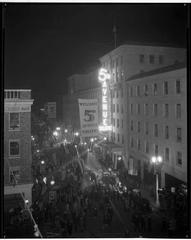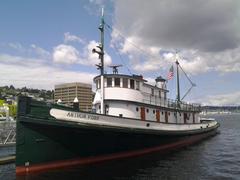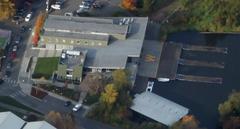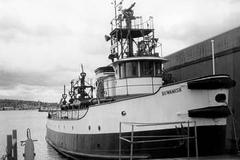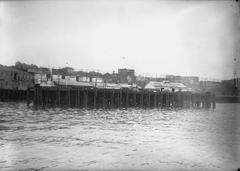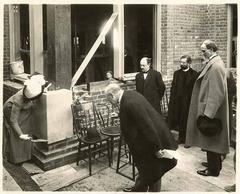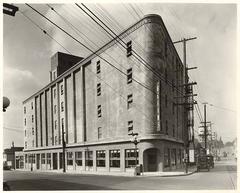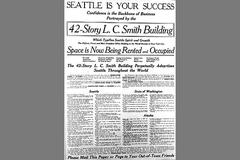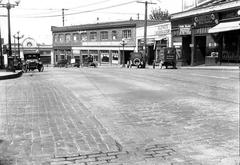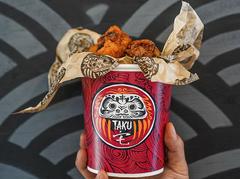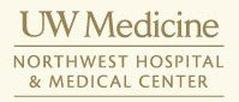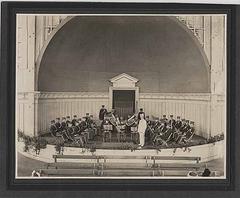Cirrus Seattle Visiting Hours, Tickets, and Travel Guide
Date: 04/07/2025
Introduction to Cirrus Seattle
Nestled in Seattle’s dynamic Denny Triangle neighborhood, Cirrus stands as a prominent example of modern urban residential living and architectural innovation. Soaring over 400 feet with its sleek glass and steel facade, Cirrus exemplifies the city’s transformation from industrial roots to a thriving, sustainable metropolis. As a LEED Silver-certified structure, Cirrus incorporates advanced energy-efficient systems, water conservation measures, and transit-oriented design, aligning with Seattle’s environmental goals and urban revitalization efforts (Seattle Department of Construction & Inspections; Weber Thompson; Westlake Consulting Group).
Although Cirrus is a private residence and not open for public interior tours, its architectural significance and location in the heart of the Denny Triangle make it a compelling destination for architecture enthusiasts and visitors. The building’s innovative design, featuring sculpted facades and stacked decks, offers a visual narrative inspired by the Pacific Northwest’s natural beauty and urban density. Cirrus serves as a striking backdrop for skyline photography and is surrounded by notable attractions, including Pike Place Market, the Amazon Spheres, and the Space Needle (Seattle Architecture Foundation; Visit Seattle City).
This guide outlines everything you need to know about Cirrus, from its historical context and architectural features to practical visitor tips and sustainability credentials. Whether you’re a prospective resident, urban explorer, or real estate professional, you’ll find valuable insights into one of Seattle’s most distinguished residential towers.
Table of Contents
- Introduction
- Historical Background of Cirrus in Seattle
- Architectural Significance
- Visitor Information
- Notable Architectural and Urban Planning Details
- Cirrus and the Future of Seattle’s Skyline
- Exploring Cirrus: Hours, Tickets, and Denny Triangle Highlights
- Sustainability and Awards
- Frequently Asked Questions (FAQ)
- Conclusion and Final Tips
- References
Historical Background of Cirrus in Seattle
The Rise of High-Rise Living
Seattle’s urban landscape has evolved rapidly, especially in the Denny Triangle. Once dominated by low-rise industrial and commercial buildings, the area experienced a significant transformation following rezoning initiatives in the early 2000s and the upzoning of the Denny Way corridor in 2013. These changes paved the way for tall, dense residential developments and attracted a new wave of high-rise towers (Seattle Department of Construction & Inspections; Seattle.gov: Downtown Urban Development).
Cirrus and Seattle’s Modern Boom
Completed in the mid-2010s, Cirrus was among the first luxury residential towers in the revitalized Denny Triangle. Its development marked a pivotal shift in downtown Seattle—from office-centric to a vibrant mix of residential, retail, and hospitality spaces. The proximity to major employers like Amazon accelerated demand for upscale urban living, with Cirrus catering to professionals seeking modern amenities and an active city lifestyle.
Architectural Significance of Cirrus
Design Philosophy and Place in the Skyline
Cirrus epitomizes contemporary architectural trends in Seattle, with clean lines, expansive glass facades, and an emphasis on natural light—hallmarks of the “Northwest Regional Style” (American Institute of Architects Seattle Chapter). Designed by Weber Thompson, its sculpted facades and stacked decks evoke the erosive power of wind and water in the Pacific Northwest, while its height—over 400 feet—places it among the tallest residential buildings in the city (Weber Thompson).
Integration with Seattle’s Architectural Heritage
Although thoroughly modern, Cirrus fits within a city known for diverse architectural styles, from Romanesque and Neoclassical buildings in Pioneer Square to icons like the Space Needle. Cirrus honors Seattle’s legacy through its quality materials, thoughtful detailing, and commitment to enhancing the urban streetscape (Seattle Architecture Foundation).
Visiting Cirrus Seattle: What You Need to Know
Access and Public Spaces
Cirrus is a private residential building and does not offer public tours or general access to its interiors. However, the ground-floor retail and surrounding sidewalks are open to the public and invite pedestrian exploration. Visitors can admire the building’s architecture and enjoy the vibrant street-level atmosphere.
Nearby Attractions and Photo Spots
Denny Triangle’s central location places Cirrus within walking distance of several Seattle landmarks:
- Amazon Spheres
- Museum of Pop Culture (MoPOP)
- Pike Place Market
- Westlake Park
- Space Needle
Prime photo opportunities are found along Westlake Avenue and at the intersection of 8th Avenue and Lenora Street, where Cirrus’s unique silhouette stands out against the city skyline.
Transportation and Accessibility
Cirrus is easily accessible via Seattle’s extensive public transportation network, including the Link Light Rail, South Lake Union Streetcar, and multiple bus lines. The neighborhood is highly walkable and features bike-friendly routes. Public areas around Cirrus are wheelchair accessible.
Notable Architectural and Urban Planning Details
- Height and Scale: Rises 440 feet (39 stories), among Seattle’s tallest residential towers.
- Design Elements: Features expansive glass, open-plan interiors, and distinctive, sculpted facades.
- Sustainability: LEED Silver-certified with energy-efficient systems and environmentally responsible materials.
- Urban Activation: Ground-floor retail and public spaces contribute to Denny Triangle’s vibrant street life.
Cirrus and the Future of Seattle’s Skyline
As Seattle continues to grow, buildings like Cirrus play an essential role in shaping the city’s evolving identity. Cirrus not only represents modern living and innovation but also demonstrates how high-rise development can align with sustainability and community goals.
Exploring Cirrus: Hours, Tickets, and Denny Triangle Highlights
Location and Getting There
Cirrus is located at 2030 8th Avenue, at the intersection of Westlake Avenue, 8th Avenue, and Lenora Street. Its prime location offers easy access to major attractions and neighborhoods, including Belltown and Capitol Hill (Weber Thompson; Visit Seattle City).
Visiting Hours, Tickets, and Walking Tours
Cirrus does not offer public visiting hours or ticketed access. The building’s interior and rooftop terrace are private, reserved for residents only. However, the ground-floor retail spaces operate during standard business hours, and guided walking tours of downtown Seattle often include Cirrus as a notable external highlight.
Photo Opportunities and Architectural Highlights
Cirrus’s facades and stacked decks provide visual interest from multiple angles. Photographers can capture dramatic shots from Westlake Avenue or Lenora Street, especially during early morning or late afternoon when the light accentuates the building’s contours.
Travel Tips and Accessibility
- Public Transit: Use the South Lake Union Streetcar, Link Light Rail, or bus lines.
- Walking: The neighborhood is pedestrian-friendly.
- Accessibility: Sidewalks and public spaces are wheelchair accessible.
- Best Photo Times: Early morning or late afternoon light enhances photos.
Sustainability and Awards
LEED Silver Certification & Sustainable Features
Cirrus was designed for sustainability, earning LEED Silver certification for its energy-efficient envelope, smart HVAC systems, water-saving fixtures, and environmentally conscious materials (Westlake Consulting Group; Seattle Sustainable Buildings Policy). Its transit-oriented location reduces car dependency and supports citywide emissions goals.
Recognition and Urban Impact
Cirrus’s green design has earned multiple accolades, including:
- 2016 NAIOP Night of the Stars High-Rise Residential of the Year
- 2017 Northwest Design Award for Outdoor Living Area
These awards highlight Cirrus as a benchmark for sustainable high-rise living in Seattle and a model for future developments (Funds for NGOs: Green Building Awards).
Frequently Asked Questions (FAQ)
Can I visit Cirrus Seattle as a tourist?
Cirrus is a private residential building; there are no public tours or general visiting hours. You can enjoy its architecture from the exterior and public sidewalks.
Are tickets required to visit Cirrus?
No tickets are needed, as there is no public access.
Where are the best places to see Cirrus?
Westlake Avenue and Lenora Street offer excellent viewpoints.
Is Cirrus wheelchair accessible?
The public sidewalks and ground-floor retail spaces are wheelchair accessible.
What makes Cirrus sustainable?
LEED Silver certification, energy-efficient systems, water conservation, sustainable materials, and ongoing energy performance monitoring.
Are there guided tours featuring Cirrus?
While you can’t tour the interior, some architectural walking tours of the neighborhood highlight Cirrus’s exterior.
Conclusion and Final Tips
Cirrus Residential Tower stands as a testament to Seattle’s vision for sustainable, modern urban living. Though not open for public interior access, its striking design, central location, and integration into the city’s transit-oriented development make it a signature landmark. Visitors can appreciate Cirrus’s architecture from the surrounding streets and complement their experience by exploring nearby attractions such as the Amazon Spheres, Pike Place Market, and the Space Needle.
To deepen your exploration of Seattle’s architecture and urban development, consider downloading the Audiala app for interactive city guides and updates. Engage with Seattle’s neighborhoods, discover sustainable buildings, and experience the city’s commitment to innovation and environmental stewardship.
Image alt text: Cirrus Residential Tower Seattle showcasing its modern glass facade against the city skyline.
Seattle Department of Construction & Inspections
Internal Links:
References
- Cirrus Residential Tower Seattle: History, Architecture & Visitor Information, 2025, Seattle Department of Construction & Inspections (https://www.seattle.gov/sdci)
- Visiting Cirrus Seattle: Hours, Tickets, and Exploring Denny Triangle’s Iconic Skyscraper, 2025, Weber Thompson (https://www.weberthompson.com/project/cirrus/)
- Cirrus Seattle: Exploring LEED Silver Certified Sustainable Living and Architecture, 2025, Westlake Consulting Group (https://www.westlakeconsultinggroup.com/cirrus-apartments)
- Seattle Architecture Foundation, 2025 (https://seattlearchitecture.org/)
- Seattle Sustainable Buildings Policy, 2025, City of Seattle (https://www.seattle.gov/environment/climate-change/buildings-and-energy/city-facilities/sustainable-buildings-policy)
- Visit Seattle City, 2025 (https://visitseattlecity.com/)
- Audiala App - Explore Seattle, 2025 (https://www.audiala.com)


